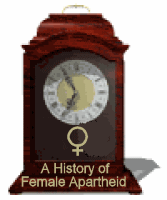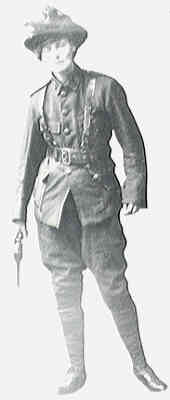
[Home] [Timeline] [Quiz] [Women Making History]

Women of History
COUNTESS MARKIEVICZ Born 1868
Constance Georgina Gore-Booth was born, in London, into a wealthy West of Ireland family. The firstborn, she was succeeded by her brother Joscelyn, then Eva, the youngest, and the one most dear to her. As girls, Constance's and Eva's legendary beauty was immortalized in a painting by Sarah Purser, and later in poem by Willian Butler Yeats.
 Even today, she is not forgotten, but her lack of tact,
strong-headedness, strident, upper-class English accent, and virago-like
temperament made her remembered for the wrong reasons. She was the first woman
ever to be elected Member of Parliament, a sometimes crude, charmless national
heroine, however, the only one honored with a statue in St. Stephen's Green. She
fought alongside men during the Easter Rising but was--and is--regarded with
ambivalence, and has been accused of undue fanaticism for her
"causes." But to Dublin's poor, she was a saint--a Joan of Arc. What
does history tell us of Countess Markievicz, the first ever woman to be elected
a Member of Parliament?
Even today, she is not forgotten, but her lack of tact,
strong-headedness, strident, upper-class English accent, and virago-like
temperament made her remembered for the wrong reasons. She was the first woman
ever to be elected Member of Parliament, a sometimes crude, charmless national
heroine, however, the only one honored with a statue in St. Stephen's Green. She
fought alongside men during the Easter Rising but was--and is--regarded with
ambivalence, and has been accused of undue fanaticism for her
"causes." But to Dublin's poor, she was a saint--a Joan of Arc. What
does history tell us of Countess Markievicz, the first ever woman to be elected
a Member of Parliament?
Constance and her sister were educated by governesses, not uncommon for girls of their social class, but certainly inadequate for the tasks which lay ahead. Eva chose poetry for her creative outlet; Constance chose painting. But other things beckoned on the horizon.
Constance once said of her indulgent life at Lissadell: "We lived on a beautiful, enchanted West Coast, where we grew up intimate with the soft mists and the colored mountains, and where each morning you woke to the sound of the wild birds .... No one was interested in politics in our house. Irish history was also taboo, for 'What is the use of grieving over past grievances?'"
They did what they could to help those poorer than themselves, for that was the family's way. But Constance remembered watching the prosperous Protestant farmers with their Scottish names, while safely hidden out of sight, and comparing their abundance with the dispossessed Gaels of the West Coast in their miserable huts. They were constant and welcome visitors at the estate cottages. Constance is remembered to have sat up with the father of a stud-groom night after night while the older man suffered a serious illness. Upon finding the groom's mother near her confinement, laboring over a wash tub, Constance sent the woman away and finished the washing herself.
Of this and other charitable acts she said: "though Irish in all one's inmost feelings, one's superficial outlook was aloof and vague." Seasons in London produced many admirers for the beautiful Gore-Booth sisters, but none suited. Eva met her lifelong friend, Ester Roper, on a holiday in Italy. For the rest of her life, she would work tirelessly to better the working conditions of women in England.
Constance tired of the life of balls and hunts, and decided to try her hand as an artist. In 1898, following a course at the Slade, she went off to Paris to study at Julien's. Here she met Casimir Markievicz, a Polish widower, younger than herself, with a small son. They fell in love and managed to secure her parents' approval to wed. Constance's father, in ill health, died before they could be married, but after a respectable period, they had a subdued wedding in London.
In 1901, Constance became pregnant and decided to return to Lissadell for her confinement. In late 1903, they moved to Dublin. In January, 1904, Arthur Griffith began a series of articles in the United Irishman that would lead the way for a national movement called Sinn Fein and at the same time, Constance would learn of Ireland's struggle for independence. Constance's days of parties and Dublin Castle events were soon to end.
By 1908, Constance had immersed herself in the theatre, the main path from which Inghinidhe na hEireann (Daughters of Erin) could effectively educate. For years they had played an important role in artistic and nationalist Dublin, and through Arthur Griffith and his urging that Irish women perpetuate a true nationalist spirit in the country by the example in their homes, they hoisted the banner. Yeats' Cathleen ni Houlihan and AE's Deirdre were first performed by the newly formed Irish National Dramatic Company and the Inghinidhe dramatic class. Constance herself had recently played in Edward Martyn's Maeve along with many actors who were avowed nationalists. While reading articles from a bundle left by one of the actors, she happened across Robert Emmett's powerful words from the dock: "When my country takes her place among the nations of the earth, then, and not till then, let my epitaph be written." In a flash, she knew she must join up. Her conversion to anti-British militarism was swift and all-consuming.
Constance attended her first Inghinidhe meeting one dank, rainy night, coming from a Castle function dressed in a blue velvet cloak, diamonds glittering in her hair, to the unattractive meeting room with its rough table and splintery chairs. The members eyed her with suspicion, were rude to her, and she loved it. She pulled off her wet shoes, placed them on the hearth, sat at the unpainted table and listened attentively as the meeting progressed. She said she liked the women from the beginning because it was the first time she had been any place she had not been "kowtowed to as a countess."
They gave her work organizing girls' dramatic classes, but she soon was bored and moved on to a class for boys. By 1909 she was on the council for Sinn Fein but she and Griffith never really got along. She was militant and he was a pacifist.
When Baden-Powell founded the Boy Scout movement, the Countess offered a nationalist scout movement. She worked with Jim Larkin and got a place to use as a Boy Scout headquarters. She christened the group Fianna after Finn's legendary warrior band. The boys learned drill, how to use firearms, signalling, first aid, and route marches. The movement grew, and new branches were formed. Larkin allotted one group a room in his newly built Liberty Hall.
During the tram workers' strike of 1913, when strikes and lockouts put 24,000 people out of work, Constance turned the basement of Liberty Hall into a food kitchen and milk depot. For six months she worked day and night, collecting the funds, cooking the food, visiting the sick in their homes, and recruiting a band of helpers from across the social strata.
As her activities increased, so did the marriage deteriorate. Casimir went off to fight on Polish soil, and Constance immersed herself even more fully into the nationalist movement. Soon she was undertaking rifle practice, determined to be as good as any of the men. She and her Fianna boys were at the Howth dock to unload the cache of rifles from the deck of the Asgaard, and she succeeded in blowing up a wall with a set of detonators brought by a friend.
The Easter Rising was doomed, but Constance played a major role as the highest ranking woman and second in command to Michael Mallin at St. Stephens Green. Upon capture, her sentence was commuted to life imprisonment because of her sex, but that, too was reduced, and after a year in Aylesbury gaol, she came home a heroine. By this time she had converted to Catholicism.
In May, 1918, she again was sentenced without trial for her part in an imaginary German plot. This time she went to England's Holloway prison with Maud Gonne and Mrs. Tom Clarke. Even more spectacular, while in prison, her name was placed as a Sinn Fein candidate for the St. Patrick's Division of Dublin. Of the seventy-three Sinn Fein candidates to be returned, thirty-six of them were in prison. Constance received her letter from David Lloyd George inviting her to take her seat while in Holloway prison.
Sinn Fein had decided to boycott the British Parliament and form its own Dail Eireann. Constance claimed her seat, this time as Minister for labour in Eamon de Valera's first cabinet.
When the Treaty was signed, Ireland became divided. Constance felt the signing was a betrayal of Ireland and quickly joined the anti-treatyites who included de Valera, Mary MacSwiney, and Cathal Brugha. When civil war broke out, once again Constance had a gun in her hands, serving under Oscar Traynor, then Cathal Brugha.
In August 1923, Constance was sentenced for the fifth time to incarceration. This time she was taken to a disused Dublin workhouse where, along with the men and women in Mountjoy gaol, she went on hunger strike, calling it off only after orders from her superiors.
Her sister, Eva, died in 1926, worn out by her work for the many pacifist causes. Constance herself was not well, but she denied that anything was wrong and continued to drill her Fianna boys and to work for the new party. When the winter brought a coal strike, Constance trudged up and down tenement stairs to bring food, fuel and necessities to the impoverished of Dublin. She herself had little more than they. It has been said she knew how to delegate authority, but she never learned to delegate kindness. For these things, these selfless acts, the poor of Dublin remember Constance Markievicz, the woman they called "Madame."
The end came on July 15th, 1927. She thought she had appendicitis. Some believe it was cancer, others overwork. She died in a public ward of a Dublin slum hospital with her family in attendance. Dublin gave her a huge funeral with a lying in state, her coffin guarded by her beloved Fianna boys. A hundred thousand people filed past the coffin, and de Valera gave the funeral oration at the Republican plot at Glasnevin.
Her detractors exist, but not among the hard core Republicans, and never among the poor.